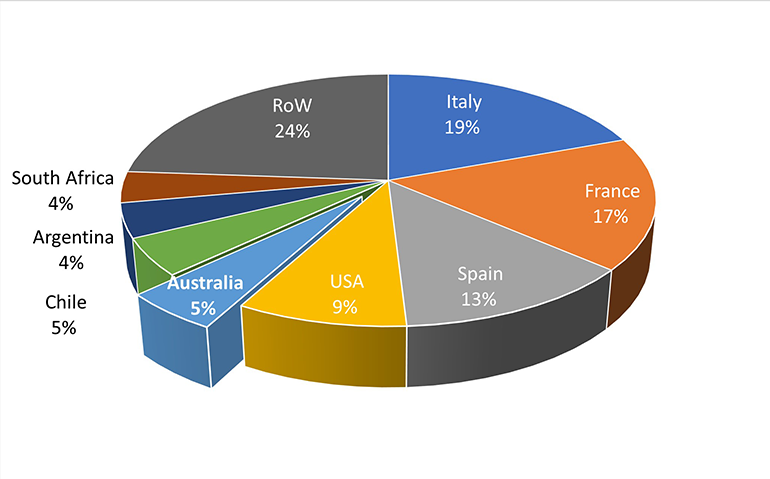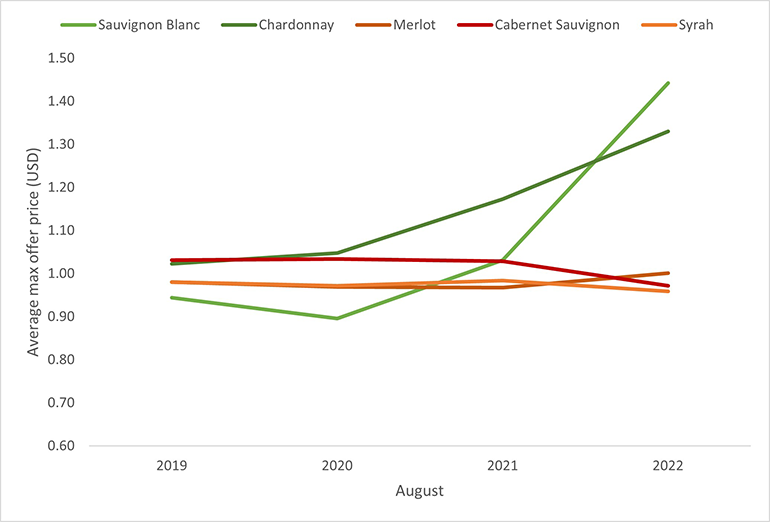Global wine production in 2022 is estimated[1] to have been almost identical to the 2021 figure, at just below 26 billion litres. This is 2 per cent below the 5-year average and 3 per cent below the 10-year average, and is the fourth year in a row that has been slightly below average. This indicates that world wine production is generally stable, consistent with the long-term trend in vineyard surface area, which has reduced by just 1 per cent in the past 10 years (Figure 1), after falling by 5 per cent in the previous 10 years.
Figure 1 Global vineyard area[2] and wine production over time

Source: OIV
How the main contributors to the global harvest fared in 2022
The reduction in volume for the 2022 vintage was not uniform, with increased volumes in the northern hemisphere – compared with 2021 – making up for a smaller southern hemisphere harvest.
Favourable conditions in the two largest producing countries (Italy and France) saw their volumes increase, particularly France’s, which was up by 18 per cent compared with the frost-affected 2021. Italy’s production was just over 5 billion litres, 3 per cent above the 5-year average and the largest since 2016. This saw it retain its position as the largest wine-producing country in the world, with a 19 per cent global share. France retained its ranking of second and increased its share from 14 per cent in 2021 to 17 per cent. Spain had a reduced harvest due to drought and limited access to water, producing 3.3 billion litres – 6 per cent below 2021 and 12 per cent below its 5-year average. Its share was reduced from 14 per cent to 13 per cent.
The other large northern hemisphere producer, the United States (US), was down by 6 per cent on its 5-year average, as a result of early frosts, summer drought conditions and lack of water supply. Its share of the global harvest was 9 per cent.
The southern hemisphere wine producers as a whole had a record-sized harvest in 2021, and in 2022 most major producers had smaller crops, but still above the 5-year average – except for Argentina, which reported a production of 1.1 billion litres, 9 per cent below its 5-year average. Australia had the largest reduction in percentage terms after its record-sized production of 1.48 billion litres in 2021, down by 12 per cent to 1.3 billion litres. Despite this, it retained its position as largest southern hemisphere wine producer, with 5 per cent of world wine production (Figure 2).
Figure 2 - Estimated world wine production share by country in 2022

Source: OIV
New Zealand was the exception to the pattern for the southern hemisphere; after having a below-average vintage in 2021, it produced a record high volume of 0.4 billion litres in 2022, up 44 per cent compared with the previous year. This was due to a record yield of 12.8 tonnes per hectare combined with an increased production base. The area of vineyard in New Zealand has grown from 35,182 hectares in 2013 to 40,323 hectares in 2021, an increase of 15 per cent. Sauvignon Blanc makes up 64 per cent of the area, followed by Pinot Noir with 14 per cent. The boost in New Zealand Sauvignon Blanc wine available on the global market in 2023 as a result of the record 2022 vintage is likely to be around 75 million litres, 2.5 times the total exports of Australian Sauvignon Blanc in the year ended June 2022.
How does supply compare with demand?
Despite the smaller than average global vintage, downward pressures on consumption, both long-term and short-term, mean that the wine market is still in over-supply, as it has been for at least the past 10 years (Figure 3).
Figure 3 - Estimated global wine supply and consumption over time

Source: OIV
Since reaching a peak in 2007, global wine consumption has generally been declining, apart from a short period of growth between 2015 and 2017, largely driven by the growth in popularity of imported wine in mainland China. The overall decline is a result of long-term reductions in per capita consumption in mature wine markets, which make up the vast majority of wine consumers, due to changing demographics, an increased focus on health and wellness (including reducing alcohol consumption) and competition from other alcoholic products, particularly spirit-based.
The decline was exacerbated in 2020 by the COVID-19 pandemic, and briefly reversed in 2021, due to the lifting of COVID-related restrictions. However, in 2022, the IWSR has forecast that consumption will decrease by 2 per cent[3], which would put the total figure at 23.2 billion litres, the lowest for at least 10 years and 11 per cent below production. To put it in context, the gap between supply and consumption in 2022 is estimated to be approximately 2.8 billion litres, more than double Australia’s total 2022 wine production.
Oversupply is concentrated in red wine
The OIV does not report production and consumption statistics by wine colour. However, it is clear from Ciatti Global Market Reports over the past two years that the oversupply, at least for commercial wines sold on the bulk wine market, is concentrated in red varieties.
The difference in demand for reds compared with whites can be seen in the global bulk wine prices reported by Ciatti. Across the major wine-producing countries combined[4], the average offer price for Shiraz (Syrah) has decreased by 18 per cent over the past five years from a peak of US$ 1.16 in 2017 to US$ 0.96 in 2022. By contrast, the average offer price for Chardonnay reached a low in 2019 of US$ 1.02 per litre and has increased by 30 per cent in the past four years to US$ 1.33 per litre (Figure 4). The Syrah price was 4 per cent higher than the Chardonnay price in 2017, and 28 per cent lower in 2022. The increase in Sauvignon Blanc has been even more dramatic, even when excluding New Zealand.
Figure 4 - Difference in average offer price between red and white varieties on the global bulk wine market over time (major wine-producing countries combined)

Source: Ciatti
The average offer price for selected major red varieties[5] on the global wine market across all major wine-producing countries was 15 per cent higher than for a selection of the main white varieties[6] in 2019, and by 2022 the average price for the same red varieties was 20 per cent lower than for the white varieties.
The different fortunes of reds and whites has come about for two main reasons. First: the sudden drop in demand for red wine from mainland China, after a few years of rapid growth in that market fuelled a shift in the supply mix towards reds. This applied particularly to Australia, but has also been experienced in Bordeaux, with flow-on effects to the other major producers. Second: successive small global harvests of white wine, particularly Sauvignon Blanc, have seen supply unable to meet demand. It should be noted, though, that there is no evidence for any significant overall increase in consumer demand for white wine that would warrant an increase in white wine production – particularly now that New Zealand’s supply has been restored to above average levels.
Given the long-term overall decline in wine consumption, particularly among younger consumers, there is a need for what Ciatti has called ‘a better understanding of the evolution of consumer behaviour in order to adapt production for the next 10–20 years’. Otherwise, continuing global oversupply particularly in red wine seems inevitable.
---
[1] International Organisation of Vine and Wine (OIV) preliminary estimates October 2022.
[2] Includes vineyards used for tablegrapes and dried grapes as well as winegrapes.
[3] An OIV official estimate for 2022 will not be available until late 2023
[4] Argentina, Australia, US, Chile, France, Italy and Spain
[5] Syrah, Cabernet Sauvignon, Merlot and generic red
[6] Chardonnay, Sauvignon Blanc, generic white
